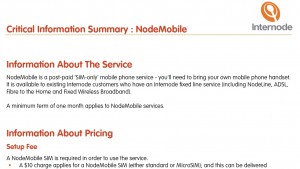 Even though it won’t be compulsory for service providers to publish Critical Information Summaries until 1 March 2013, iiNet’s Internode division has released the first CIS we’ve seen in the wild.
Even though it won’t be compulsory for service providers to publish Critical Information Summaries until 1 March 2013, iiNet’s Internode division has released the first CIS we’ve seen in the wild.
We’re certainly not going to get picky about this. After all, it takes gumption to go first. But since Internode has given the industry a starting point, we will take a look at it.
Background: The TCP Code doesn’t include a CIS template
The TCP Code is very prescriptive about the core elements of a CIS including its title, headings, order and core content. But it doesn’t actually contain a document template, so each telco needs to create its own. That’s one reason Internode’s effort is so interesting.
Internode’s approach
Sensibly, Internode has selected a pretty simple product for its first shot at a CIS. The NodeMobile offers are a no contract monthly mobile plan at three price points, available only to Internode customers with a fixed line voice or data service. So it doesn’t exactly stress test the Code’s CIS formula.
What we noticed
The Code’s rigid order raises legalistic questions
The TCP Code expressly mandates that information in a CIS must be in the order laid out in the Code. Internode’s CIS shows that this is not as simple as you might think.
According to the Code, the first info item in a CIS has to be a description of the offer, including any bundling conditions, followed by any minimum term, followed by any other conditions or qualifications.
In the case of Internode’s offer, only Internode fixed line customers qualify. Is that properly characterised as a bundling condition, that should appear before the minimum term or an offer qualification, that should be listed after the minimum term? Apparently Internode considers it a bundling arrangement, since the requirement precedes the minimum term.
That’s what happens when you make very detailed rules
What this makes clear is the price to be paid for regulating a document so tightly. It introduces fine, legalistic distinctions that are quite unfortunate. But apparently the regulator was so concerned that the industry would not, or could not, follow a more general product disclosure requirement in accordance with its spirit that it deemed it necessary to lock down the rules very specifically.
The pricing information isn’t clear or prominent
We think this is not Internode’s fault (except for one issue – see below). Internode has followed the rules, but it seems that the rules don’t really assure clear, prominent pricing info in a CIS.
The key piece of info we want about a mobile voice plan is what it will cost to make a call. There’s not a word about that on the first page of the CIS (and any busy person will tell you that if key info isn’t on the first page of a document, it’s a problem.)
The first info about call costs (or SMS costs or data costs) is on the second page, in what appears to be the smallest print in the document, under the ‘Standardised Cost Information’ heading. And the actual cost of a two minute call is in small print as the last expression in a 27 word para. It hardly hits you between the eyes.
But what’s the cost per minute?
It seems we all got so excited about the new ‘unit pricing’ requirements that we forgot to require a CIS to state the per minute call cost. The cost of a two minute call is interesting, but how do I know what a three minute call costs if the CIS doesn’t include the per minute charge?
And nothing in the TCP Code requires it to!
But doesn’t the Internode CIS state the per minute charge?
Sort of, but not clearly.
The first point is that it doesn’t have to. It could as easily have said:
The cost of a two minute call including flagfall is $2.15. Go figure what a three minute call would be.
The second point is that the quoted per minute and per SMS costs apparently only apply to usage outside the cap sorry, ‘included value’. It doesn’t tell us what the per minute or per SMS charges are for usage inside the included value allowance.
Now, working back from the info that is provided about voice calls, you can actually work out that ‘inside the minimum charge’ usage costs the same as the ‘outside the minimum charge’ usage. So, in saying that ‘the above costs apply to usage outside of the monthly included value of the plan’ Internode is (inadvertently, no doubt) making a slightly misleading statement. It (wrongly) implies that the charges don’t apply for voice calls inside the included value. But they do.
The same applies to the quoted SMS rate. Despite the note that ‘the above costs apply to usage outside of the monthly included value of the plan’ the only way it could work is if the rate applies to all SMSes, inside and outside included value.
But we shouldn’t have to figure these things out. It should be crystal clear.
What Internode was trying to say
What we think Internode really meant was that the quoted charges apply to all usage, but will only result in extra bill charges after the included value amounts are consumed. Maybe that could be simply expressed by adding just one word:
The above costs also apply to usage outside of the monthly included value of the plan.
Overall
Internode has wisely begun with a simple product, and overall its CIS looks pretty good. Other products and plans will be much more challenging to shoehorn into the mandatory format. But good on Internode for taking a lead and showing us how it can be done.



